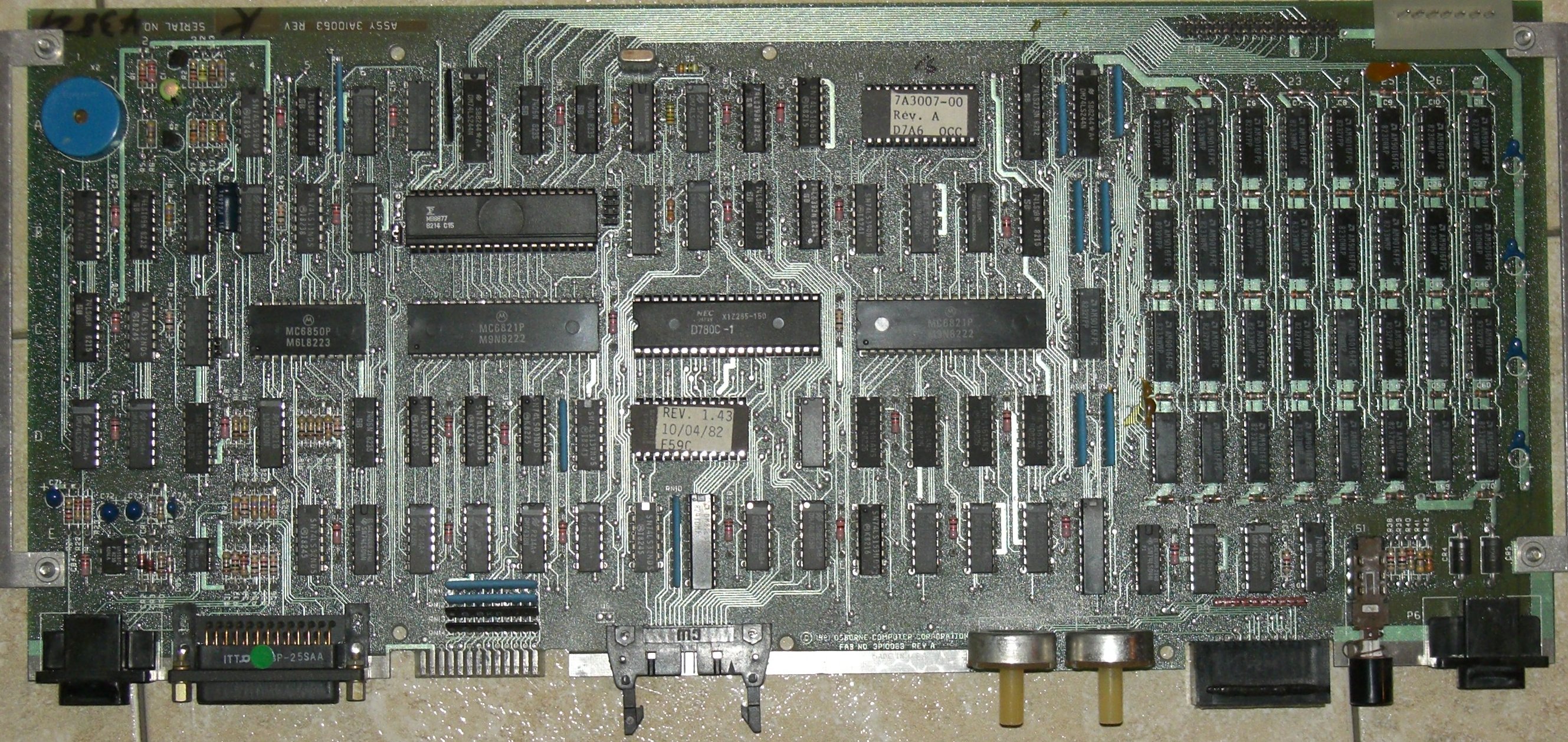I’m a pretty diehard collector, so one would expect I’d already have a key milestone in computing, the ‘portable’ Osborne 1, in my collection.
Nope.
There’s a variety of reasons – one being that I kept getting lured off to more interesting machines. The other being that, I just had a sneaking suspicion vintage computer prices were too high and bound for a correction. Especially on something like the Osborne 1 (O1), which a decade ago was fetching hundreds of dollars. The O1 is not a rare machine by any stretch. It was famously successful, with Osborne ultimately producing tens of thousands of units before they ran into trouble with the successor model, the Executive. My strategy, such that I had one, was to just wait.
While I waited, I learned that in fact, there were a couple of variants of O1. The first 10 machines produced as prototypes were sold with metal cases. They looked like this:

The prototypes appeared in much of the advertising. But the actual production design used plastic for the cases. The first O1s looked more like this:

Later in production, the decision was made to revise the case design to incorporate a sturdier plastic. These machines are distinguishable from the first O1s by changed ‘bezel’ around the floppy drives. The drives behind the bezel and the guts of the machine are still the same – just the casing is different. The keyboard also received a ‘gully’ above the keys. Not sure what the purpose was.. maybe to hold pens? Anyway, this revised model was officially designated the Osborne 1a.

I had a several years’ think about it, and ultimately decided I wanted the original O1. I like the rougher look a bit better, and anyway, as a collector you tend to go as early as you can. I made no special effort to find one, prefering instead to wait until an opportunity presented itself. And sure enough it came up on ebay.
$99!! And a super low serial to boot – 337! Sure, the front bezel has been Swiss Cheesed by someone (rightly) concerned about heat dissipation. And okay, it doesn’t work. But when you are talking over 100,000 units produced, a number in the low hundreds is pretty unique. Plus the price was right! Who knows what I might find in there, this early in production? I know from experience with other makes and models that the earliest units sometimes have little differences from later, owing to tweaks during the production process. Anyway, I snapped it up.
When it arrived a couple weeks later, I naturally set to figuring out what was going on. From the description and pictures, I thought it was a simple case of bad RAM or similar. It seemed like it was being frozen at a garbage screen. However, that’s not quite what was going on. In fact, the machine behaved like it was possessed. Check it out yourself:
https://youtu.be/L1pnZtLOwaM
Taking apart the Osborne was a breeze – partly due to the fact that someone else already had and had not replaced about half the screws!
Anyway with the guts out, I tried the RAM piggybacking trick. You basically install a RAM chip of same type over an existing chip. If it’s bad, the good chip will complete the circuit correctly and the machine in theory will start working. If not, then that chip is likely working and you repeat with the next chip and so on until you find the culprit(s). Then you replace the bad chip(s). But no dice here. I even went full on and took a complete working set of 4116 RAMs from my Apple IIs and tried piggybacking the whole thing, but to no avail.
I then went into more rudimentary checks -I checked the voltages on the power supply, removed and checked the CPU in another machine (it was fine) and so forth. Nothing seemed to make any difference. I consulted photos and schematics, trying to decide where to hunt next. That’s when I discovered something odd: my O1’s motherboard didn’t look like the standard O1 board at all! Check it out. In the first pic is the standard O1 board. The second pic is mine.

The basic shape is the same, but everything is laid out differently! The external ports and brightness/contrast knobs are in their usual positions on mine, but the placement of the ICs – the CPU, floppy controller and such is totally differerent on my board! Same with the speaker and all the support logic. And check out that football field of nothingness on the far right side of my board! That’s a lot of unused space! The board in the topmost pic has just two EPROMs, mine has three! The date codes on most of the ICs, meanwhile, are almost all from 1980, a year before production got rolling. Only the EPROMs and one or two support chips are a little later.
I started digging around but every earlier O1 I found had the same motherboard as in the topmost photo. And I found machines considerably earlier than mine — down to serial number 55! — but they all seemed to have the same board as in the top photo. None had one like mine. Definitely it appeared that my board was an earlier revision than the others. I began to salivate as one word crossed my mind: prototype. You might wonder why a prototype board would appear in a machine several hundred units into production, but’s it’s not unheard of. Every dollar counts, and companies sometimes do strange or unusual things to move inventory. The Apple Lisa saga comes to mind – it’s believed a certain quantity of unsold Apple Lisa 1s were converted from 5.25″ Twiggy drives to 3.5″ Sony drives by Apple itself, and then sold as Lisa 2s. Some sold even still had their original Lisa 1 serial numbers intact. I have also seen examples of companies putting prototype or early-production components into current production machines, or even just putting a production serial number on a prototype/pilot run machine and selling it, just to clear them out. I was guessing that maybe my unit was a prototype/pilot machine that got issued a serial number and sold shortly after production started.
I decided to reach out to the O1’s designer on this one, Lee Felsenstein, via email. Lee emailed back said the board definitely appeared to be based on the prototype boards. The large empty space, he explained, would have been for linear voltage regulators installed on those units, which apparently had been revised out in mine. In particular, he found the handwritten revision number, in black marker at top left, to be interesting, as it wasn’t common practice to do that.
Lee couldn’t account for why this unusual and apparently very rare board ended up in SN 337, but his thoughts were close to mine – simply that someone, either by accident or intention, decided to install it. It could have been as simple as the board inadvertently being slipped in amongst the regular production boards at the factory. Or maybe on purpose, if someone in inventory wanted it gone. It could have been an early warranty replacement scenario and this prototype board just happened to be available as the replacement. Or maybe an employee owned this unit and built it this way themselves. It’s likely impossible to know for sure, although I will try to reach out to other Osborne people as Lee suggested and see if anyone recollects anything. All the same, it appears to be a one off situation. I’ve been researching madly since and still cannot find another unit that has one following this design. What a lucky break!
As a precaution, I had the EPROMs dumped and looked at by friends with much better skills at handling code than I am. One of the EPROMs is the standard character generator, same as all the other units. The BIOS version appears to be 1.3, which also was common on the earlier units. The only difference is mine has the BIOS split across two 2716 EPROMs, whereas in the main production board this is all on a single 2732.
In terms of operation, therefore, when (if?) the board is working, it should basically behave just like a regular O1. It’s quite possible it may have had an earlier BIOS installed previously – despite most ICs being from 1980, the two EPROMs both date to 1982. It seems to me like the board was built and used in some capacity before being configured to operate like the other production boards.
Unfortunately this rarity comes at a price – diagnosing why this machine won’t operate properly is going to be tricky since no schematic appears to be available for this board revision. I’ll keep plugging away at it.. but yeah… you learn something new every day, huh?




Regarding the gully in the keyboard, I thought it was to accomadate the coiled cord while the case was closed. I believe that is the version my father had, but my memory is bad because I think I was five years old when I was playing games on it.